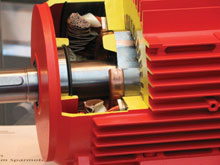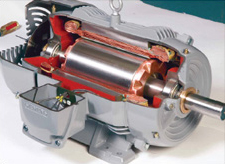Motor Rotors
Whether we realize they are there, whirring quietly in the background, electric motors power our daily lives. Washing machines, automobiles, refrigerators, computers, vacuum cleaners, power tools, microwave ovens, clocks, air conditioners - all depend on small motors to convert raw electricity to motive power. And that's just a short list of items found around a home. Industry depends on countless electric motors to keep its wheels turning and factories producing.
Why Efficiency Matters
According to the U.S. Department of Energy, electric motors use approximately 23 percent of all the electricity generated in the United States. Roughly 70 percent of all electricity used by U.S. industry is devoured by motor-driven systems. At current electrical consumption rates, a one-percentage point increase in electrical motor energy efficiency could save over 20 billion kilowatt hours of electricity per year, equivalent to 3.5 million barrels of oil annually in the USA, alone.
Copper has been a key component in motors since they were invented by Michael Faraday in 1831. It's used for the wire windings in the stationary portion (stator) of the motor, due to its superior electrical conductivity. The more windings, the more efficient the motor.
Copper is extensively used also in large motors (500 hp and above) for bars in the rotating portion (rotor) of the motor to achieve maximum efficiency. However, its use in the rotors of smaller motors has not been practical due to die-casting limitations. For these smaller motors, aluminum, a less efficient conductor, has been used in the rotor assembly.
For many years, engineers have looked at ways to incorporate copper into the armatures, or rotors, of these smaller motors as a way to increase their efficiency and reap substantial energy savings. But, for a variety of reasons, these initiatives were met with limited success.
Now, thanks to some innovative, ground-breaking research by the Copper Development Association (CDA), the International Copper Association (ICA), and a number of corporate partners including Siemens Energy & Automation, FAVI S.A. and SEW Eurodrive, the die-cast copper rotor is playing a key role in revolutionizing electric motors.
According to John Caroff, Siemens' marketing manager, "We are excited by the potential for electric motors with copper rotors in the North American market. Years of research into copper die-casting technology has led to this breakthrough where we can offer electric motors with reduced weight, increased energy efficiency, and which can run cooler than their aluminum counterparts for extended service life." Siemens recently introduced several lines of ultra-efficient motors to the North American market, with other manufacturers expected to follow suit.
Why Copper?
Most motor rotors in operation today are made from aluminum using a die-casting process where the molten metal is poured into a die, or mold, and cooled. In use since the 1930s, aluminum die-cast rotors are easily manufactured and widely used.
Copper rotors offer a number of advantages over their aluminum counterparts. Because less volume of copper than aluminum is required for a given motor, a smaller, lighter motor can be manufactured offering equivalent performance. This can lead to a significant reduction in long-term operating costs. Likewise, using the same volume of copper as aluminum in the rotor of a given motor can result in a motor of the same size but with greater performance.
Another advantage of copper is that high efficiency motors with copper rotors operate at lower temperatures then their aluminum counterparts. A general rule of thumb among motor designers is that motor life doubles with each 10°C reduction in operating temperature. This is critical, as increased motor maintenance and replacement costs are directly related to higher operating temperatures. Operating costs over the lifetime of the motor are reduced, while the motor itself lasts longer, further enhancing the investment in the copper technology.
Endless Potential
As energy costs continue to spiral, everyone is looking for ways to conserve. Die-cast copper rotors can help boost motor efficiency by one to five percentage points. Even small increases in motor efficiency can lead to billions of dollars of savings and less dependence on fossil fuels. Cu
Resources:
Also in this Issue:
- Wind Power: A Positive Future
- Motor Rotors
- Flex Copper Circuits: Clean and Conductive
- From Copper to Bronze to Conquest
- CPUs Reach Their Potential Through Copper: The Hottest Computers Depend on Copper

 SEW EFF1 motor with cast copper rotor.
SEW EFF1 motor with cast copper rotor. Cross-section of copper rotor in an electric motor.
Cross-section of copper rotor in an electric motor.